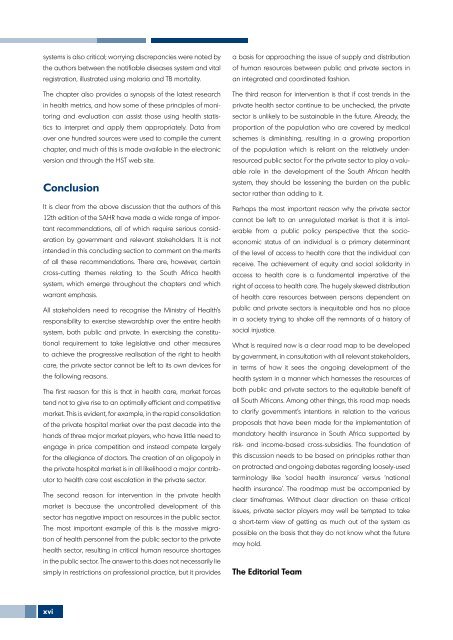SAHR 2007 - Health Systems Trust
SAHR 2007 - Health Systems Trust
SAHR 2007 - Health Systems Trust
Create successful ePaper yourself
Turn your PDF publications into a flip-book with our unique Google optimized e-Paper software.
systems is also critical; worrying discrepancies were noted by<br />
the authors between the notifiable diseases system and vital<br />
registration, illustrated using malaria and TB mortality.<br />
The chapter also provides a synopsis of the latest research<br />
in health metrics, and how some of these principles of monitoring<br />
and evaluation can assist those using health statistics<br />
to interpret and apply them appropriately. Data from<br />
over one hundred sources were used to compile the current<br />
chapter, and much of this is made available in the electronic<br />
version and through the HST web site.<br />
Conclusion<br />
It is clear from the above discussion that the authors of this<br />
12th edition of the <strong>SAHR</strong> have made a wide range of important<br />
recommendations, all of which require serious consideration<br />
by government and relevant stakeholders. It is not<br />
intended in this concluding section to comment on the merits<br />
of all these recommendations. There are, however, certain<br />
cross-cutting themes relating to the South Africa health<br />
system, which emerge throughout the chapters and which<br />
warrant emphasis.<br />
All stakeholders need to recognise the Ministry of <strong>Health</strong>’s<br />
responsibility to exercise stewardship over the entire health<br />
system, both public and private. In exercising the constitutional<br />
requirement to take legislative and other measures<br />
to achieve the progressive realisation of the right to health<br />
care, the private sector cannot be left to its own devices for<br />
the following reasons.<br />
The first reason for this is that in health care, market forces<br />
tend not to give rise to an optimally efficient and competitive<br />
market. This is evident, for example, in the rapid consolidation<br />
of the private hospital market over the past decade into the<br />
hands of three major market players, who have little need to<br />
engage in price competition and instead compete largely<br />
for the allegiance of doctors. The creation of an oligopoly in<br />
the private hospital market is in all likelihood a major contributor<br />
to health care cost escalation in the private sector.<br />
The second reason for intervention in the private health<br />
market is because the uncontrolled development of this<br />
sector has negative impact on resources in the public sector.<br />
The most important example of this is the massive migration<br />
of health personnel from the public sector to the private<br />
health sector, resulting in critical human resource shortages<br />
in the public sector. The answer to this does not necessarily lie<br />
simply in restrictions on professional practice, but it provides<br />
a basis for approaching the issue of supply and distribution<br />
of human resources between public and private sectors in<br />
an integrated and coordinated fashion.<br />
The third reason for intervention is that if cost trends in the<br />
private health sector continue to be unchecked, the private<br />
sector is unlikely to be sustainable in the future. Already, the<br />
proportion of the population who are covered by medical<br />
schemes is diminishing, resulting in a growing proportion<br />
of the population which is reliant on the relatively underresourced<br />
public sector. For the private sector to play a valuable<br />
role in the development of the South African health<br />
system, they should be lessening the burden on the public<br />
sector rather than adding to it.<br />
Perhaps the most important reason why the private sector<br />
cannot be left to an unregulated market is that it is intolerable<br />
from a public policy perspective that the socioeconomic<br />
status of an individual is a primary determinant<br />
of the level of access to health care that the individual can<br />
receive. The achievement of equity and social solidarity in<br />
access to health care is a fundamental imperative of the<br />
right of access to health care. The hugely skewed distribution<br />
of health care resources between persons dependent on<br />
public and private sectors is inequitable and has no place<br />
in a society trying to shake off the remnants of a history of<br />
social injustice.<br />
What is required now is a clear road map to be developed<br />
by government, in consultation with all relevant stakeholders,<br />
in terms of how it sees the ongoing development of the<br />
health system in a manner which harnesses the resources of<br />
both public and private sectors to the equitable benefit of<br />
all South Africans. Among other things, this road map needs<br />
to clarify government’s intentions in relation to the various<br />
proposals that have been made for the implementation of<br />
mandatory health insurance in South Africa supported by<br />
risk- and income-based cross-subsidies. The foundation of<br />
this discussion needs to be based on principles rather than<br />
on protracted and ongoing debates regarding loosely-used<br />
terminology like ‘social health insurance’ versus ‘national<br />
health insurance’. The roadmap must be accompanied by<br />
clear timeframes. Without clear direction on these critical<br />
issues, private sector players may well be tempted to take<br />
a short-term view of getting as much out of the system as<br />
possible on the basis that they do not know what the future<br />
may hold.<br />
The Editorial Team<br />
xvi
















